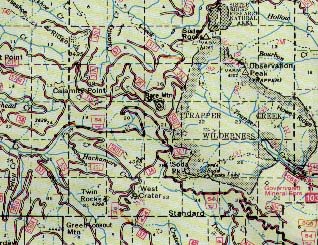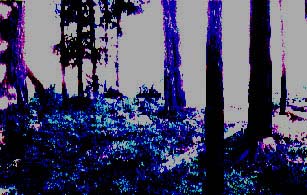|
|
 |
 |
I'm not lost, merely "turned around" by Bob Knopf Fortunately, few outdoorsmen experience the true panic of being lost ... although veteran outdoorsmen have usually been "turned around" for a short time or two. Being lost is not fun, nor is it good for the weak at heart. However, getting lost or turned around is inevitable if you spend much time in the remote outdoors.
However, anyone who spends much time in the outdoors, even if it's navigating a motorhome down a winding back road, will gain piece of mind by knowing how to use a map and compass. The first step is to always carry a map and compass. Always. Second, spend a few quiet minutes becoming familiar with any maps you'll need to use. When reviewing a map, look first at the legend and become acquainted with all the symbols. Look up any symbols or marks you don’t understand. This is always time well spent, and is something all map readers need to do. Soon you'll learn little clues that can help pinpoint your location. It's simple to trace along one road to the intersection of another to find your location at the junction. But other, more subtle indicators such as: roadside rest areas, a county line, creek and river crossings, railroad tracks, powerlines, points of interest, and topographic features can be used to trace your travel and to determine your exact location. The secret is to examine the map looking for the smallest detail. Many clues are easily overlooked. For example, is the next intersection a right angle intersection or a Y? Once you begin to observe map details, you ll be amazed at how well you can determine your location. Be sure to learn to tell approximate distances by using the scale of the map or by numbered markings if present. If you leave highways behind, maps are doubly important, but you should also know how to use a compass. As you first leave your vehicle, note (by compass) the general direction you'll be traveling. As you travel, make mental notes of hills, valleys, rock outcroppings, streams, powerlines, lakes, swampy areas, industrial or road noises ... all of which can help you find your way if you become turned around. Notice on which side the sun is. Veteran hikers, who navigate backcountry areas, always begin their trip by taking careful compass readings at the car. They carry a quality compass and know how to use it. They carry a good map, and have studied it, perhaps for hours. They know their general course of direction, and have already looked on the map for select landmarks and topographical features. As they travel they stay attune to their location and make regular checks of their location, making careful note of landmarks. After some practice, it is easy to stay on course, or at least to quickly determine your location. Beginners need to take compass readings more frequently. It’s okay to practice in a local woodlot and for fun see if you can travel a loop, or find a road by compass only.
As it gets dark, veteran outdoorsmen pay particular attention to their location. As darkness approaches, not pitch blackness, decide whether you can find your way out or not. If not, this is the time to prepare to spend the night. You’ll need to prepare mentally first, then physically by finding or making some shelter. Perhaps a small fire. If you'll camp overnight, make camp before full dark. If you become lost or turned around as darkness falls, plan to stay put unless you can follow a road or a creek, or unless you hear cars or trucks on a highway, or if you have an emergency and must get out. Use your instincts and your memory to figure which way out, but don't succumb to panic. If you're hopelessly lost, find shelter in the immediate area, stay put and try to make yourself comfortable for the night. Things will be brighter in the daytime. Comfort yourself by realizing the great story you'll be able to tell, or maybe you can write a book. There are two things that all lost persons wish. First, they wish they had learned to use a map and compass ... and that they had carried it with them. Second, they wish they had paid more attention to their overall direction of travel, and had left more time to get to their destination.
An America Outdoors Feature. All Rights Reserved. |
|
|
| Site design by Outdoor Management Network Inc. Copyright © 2005 Outdoor Management Network Inc. America Outdoors® is a registered trademark of Outdoor Management Network Inc. |
 There seems to be two kinds of people in
the world. One person appears to have
innate map reading skills ... the other person
can't consistently find their way from one
end of town to the other.
There seems to be two kinds of people in
the world. One person appears to have
innate map reading skills ... the other person
can't consistently find their way from one
end of town to the other. If or when you’re in a remote area and you
become turned around, stop immediately and
relax. Be in no hurry, which is opposed to the
traditional panic reflex that makes you want to
get out of the situation fast. Thoughts of
approaching darkness need to be controlled.
Think about which general direction you've
been heading. Have you crossed any creeks,
climbed uphill or downhill? Have you crossed
a road or heard any cars or trucks? What
about power1ines, railroad grades, lakes or
other landmarks. Don't move until you have a plan to find your way back, or onward to your final
destination.
If or when you’re in a remote area and you
become turned around, stop immediately and
relax. Be in no hurry, which is opposed to the
traditional panic reflex that makes you want to
get out of the situation fast. Thoughts of
approaching darkness need to be controlled.
Think about which general direction you've
been heading. Have you crossed any creeks,
climbed uphill or downhill? Have you crossed
a road or heard any cars or trucks? What
about power1ines, railroad grades, lakes or
other landmarks. Don't move until you have a plan to find your way back, or onward to your final
destination. Bob Knopf has writing and photography credits in over 100 outdoor and travel
magazines ... on a variety of fishing, hunting, camping, outdoor, conservation and
travel topics. Bob is an active member of the Outdoor Writers Association of
America and the Northwest Outdoor Writers Association, and has served on the
board of directors of the Outdoor Writers Association of America.
Bob Knopf has writing and photography credits in over 100 outdoor and travel
magazines ... on a variety of fishing, hunting, camping, outdoor, conservation and
travel topics. Bob is an active member of the Outdoor Writers Association of
America and the Northwest Outdoor Writers Association, and has served on the
board of directors of the Outdoor Writers Association of America.